April 13, 2017
The Fashionable Come-back of the Magical Six-Yards
The six-yards magic has cast its spell from the Swadeshi Movement to the #100sareepact. The Indian saree can be traced back to 2800 – 1800 BC, during the Indus Valley Civilization. Its fairy-tale stands unparalleled in appeal and variety. A classic by itself, the saree can be dressed up or down to suit all occasions. It is versatile enough to sit smart in the wardrobe of women of all age and professions. Just like we cannot forget Indira Gandhi in her quintessential traditional sarees, the appeal of Sridevi in her aqua-blue chiffon saree in the movie Mr. India, stands unfading.
Almost every girl child in India grew up playing in their mother’s saree. For them, it was a symbol of ‘growing up’. But with the twist of time and availability of easy-to-wear western casuals and fusion clothes, the saree lost its glory among the youth and working women. The kurta and the stress-free leggings overpowered the draping yards. The changing climate and the fast paced life of the woman, who balances the home and the work place with élan, naturally said ‘adieu’ to the saree.
However, with the conscious move of the fashion domain towards ‘handmade’ and ‘localisation,’ designers started looking inside their own treasure houses. India has an enviable wealth of traditional sarees, from Jamdani to Patola, from Telia to Kanjeevaram, to name a few. Riding the waves of ‘Make in India’ and the mindful introduction of the celebrated #100sareepact, an initiation by two Bengaluru-based friends, Anju Maudgal Kadam and Ally Matthan, the saree has found its deserving place in the wardrobe of the youth as well. They made the best of the selfie-obsessed generation to flaunt their ‘saree-clad-selfies’ and tag them as #100sareepact. I too am a ‘happy victim’ of the selfie, and therefore adopting the #100sareepact was a natural following. It not only fanned my love of great selfies but ensured I wear 100 sarees (and land up buying several). This indeed gave an impetus to our weavers who are happy to declare that the move towards sarees has given them a fresh lease of production, thereby improving their living standards. This gives us reason to smile responsibly.
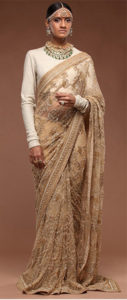 |
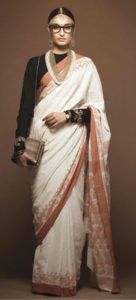 |
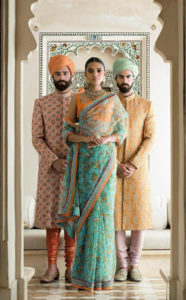 |
The Sabya Saree Tale
Holding the hands of ace designers like Ritu Kumar, Tarun Tahiliani and Sabyasachi Mukherjee, the Indian bride has embraced the saree into the many folds of the Big-Fat-Indian-Wedding. Being a ‘Sabya Bride’ has become a prestige for many. Sabyasachi pioneered the use of Indian textiles in a modern perception, thus initiating ‘Save the Saree’ project. He retails hand-woven sarees on a non-profit basis and the entire proceed goes to handloom weavers in Murshidabad. The cause is vigorously supported by actors including Aiswariya Rai Bachchan, Vidya Balan, Rani Mukherjee etc. Sabya has been involved in reviving cotton Benarasi sarees in pure khadi. He showcased them in Winter-Festive Lakme Fashion Week 2011.
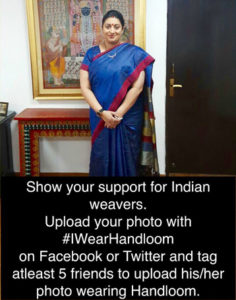 |
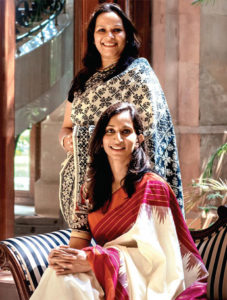 |
Social Media plays a conspiring role: Be it Smriti Irani’s tweets or the Bengaluru based iconic #100sareepact movement
At Lakme Fashion Week, Spring-Summer ‘17, as many as fifteen designers showcased their sarees on the ramp including two GenNext designers. Khadi and handloom played a big role supported by the Ministry of Textiles. The ramp seems to echo the call of Textile Minister, Smriti Irani’s twitter campaign #IWearHandloom posted on 1 August 2016 that went viral even among celebs. At LFW, Soumyadeep Datta’s ‘Laal paar saada saree’ in muslin was paired with sporty shoes. Ka Sha gave the youth its present muse the ‘Ruffle Saree,’ as did Farah Sanjana. Nakita Singh presented a linen and khadi saree line titled ‘Outline’, inspired by line sketching. Sailesh Singhania showcased his khadi sarees woven with real gold zari, inspired from nature with motifs from the Pichhvai paintings like cows, squirrels, cranes etc.
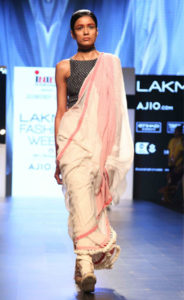 |
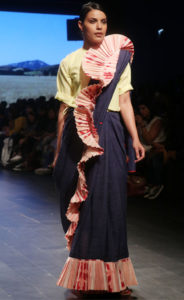 |
 |
The SS-17 at LFW saw the Twist in the Saree Tale by Soumyadeep Datta, Ka Sha & Tarun Tahiliani
Tarun Tahiliani presented the best in florals. He also experimented with the drape of the saree, thus giving us back a new version of the ‘gown saree’ that he pioneered long back. Another milestone in experimental drape was the ‘Chhotu Saree,’ introduced by Sabya in 2009, inspired by the tribal women.It ended six inches above the ankle hence giving more freedom and reasons to sport a saree. The saree today has made a fashionable comeback with more celebs flaunting them like never before, thus consequently inspiring us. A saree is now a matter of experiment and is here to stay.

